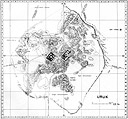The Rise of States
The first states in the Middle East had developed by 3200 BCE, after perhaps 500 years of relatively rapid increases in the power of the elite in Egypt and Mesopotamia. The rise of the state profoundly transformed nearly every aspect of social life. This is the period in which the first cities, like Uruk and Nagar (modern Tell Brak) in Mesopotamia, were built. Earlier settlements had housed perhaps 3,000 people, but these early Mesopotamian capital cities may have been home to 20,000 people or more. Early Egyptian cities like Nekhen (modern Hierakonpolis) and Memphis appear to have been smaller than their Mesopotamian counterparts.
With that many people living in one place, it was no longer possible for them all to grow their own food. Farmers living in the city itself would have had to travel to their fields and back to their home in the city each day. Walking, or perhaps riding a donkey, they could only travel about 3 miles from the city and still have time to work the fields and return home. There simply was not enough land within walking distance of these cities to feed everyone who lived there—food had to be brought in from a rural countryside.
The existence of these early cities thus tells us that economic specialization had reached new levels—some people were farmers and herders, but for the first time in human history, some households did not produce their own food. The people who did not farm specialized in other activities. Some were artisans; the art of the first cities is significantly more complex and refined than in earlier times. Others were kings, or scribes who developed the first writing and record-keeping systems. Carved seals were used in both Egypt and Mesopotamia as symbols of these offices.
The concentration of power and the concentration of labor in the first cities enabled construction of monumental buildings including temples, palaces, and city walls in Mesopotamia, and eventually the great pyramids at Giza in Egypt (built in about 2575-2500 BCE).
Early states developed ideologies that justified the new social order. One aspect of ancient Egyptian ideology held that the Egyptian state had well-defined borders—Aswan in the south and the Nile Delta in the north—and that these borders were defined in part by ethnic difference. Outside the borders were Libyans to the west, Nubians to the south, and Asiatics to the northeast, while within its borders lived Egyptians. This ideology defined the ancient Egyptian state in terms very similar to modern nation-states.
Mesopotamia and Egypt were organized as states before 3000 BCE, and other areas across the Middle East were forced to develop their own cities and states in political, economic, and military reaction to these early centers of political complexity.

 Geoff Emberling
Geoff Emberling
Former Chief Curator, Oriental Institute Museum of the University of Chicago
Guiding Questions
1. How do societies make decisions when they are small scale? How do those patterns of decision-making change as those societies grow larger?
2. What stages did some societies go through as they developed into empires? What are some differences between settlements of 3,000 people and those with 20,000 people?
3. What special qualities and sophisticated elements characterize the early Middle Eastern cities?


 Print Page
Print Page



